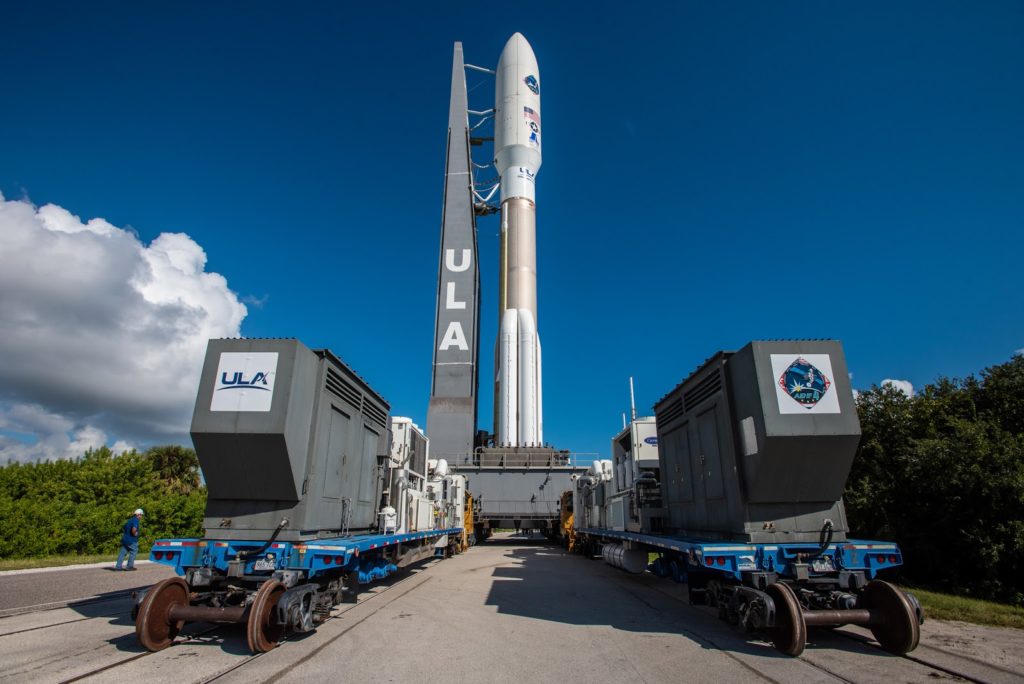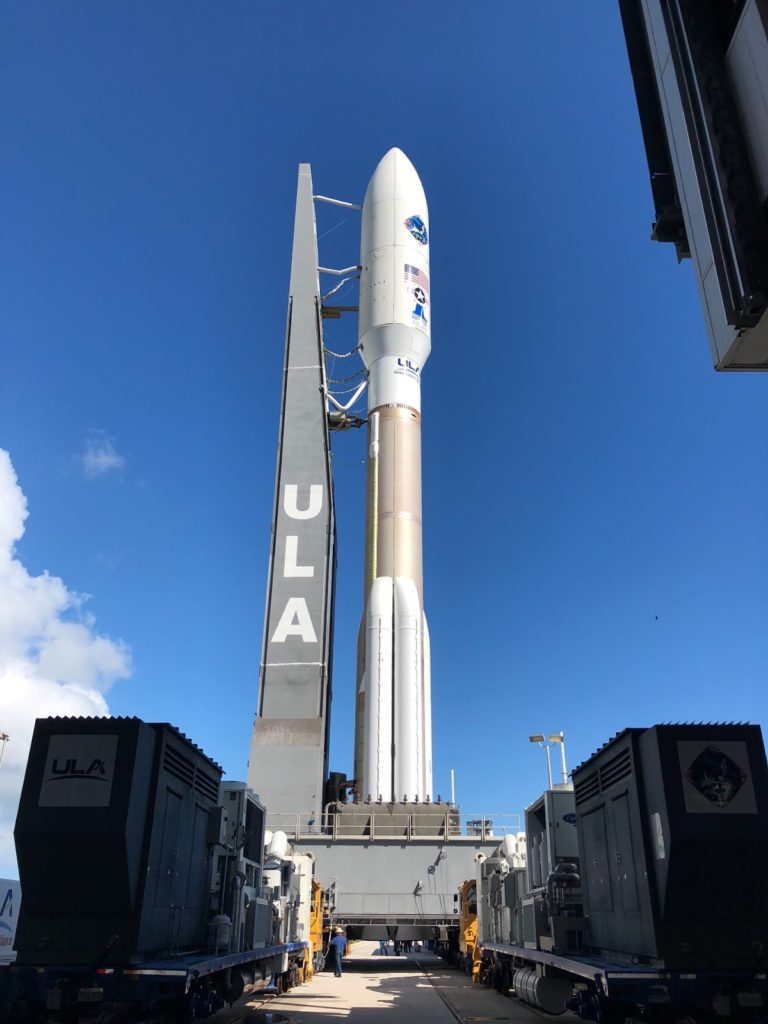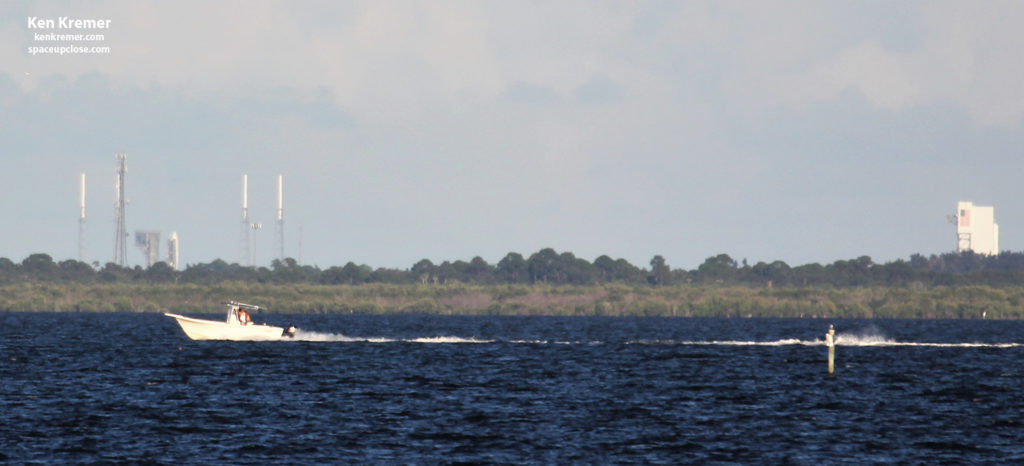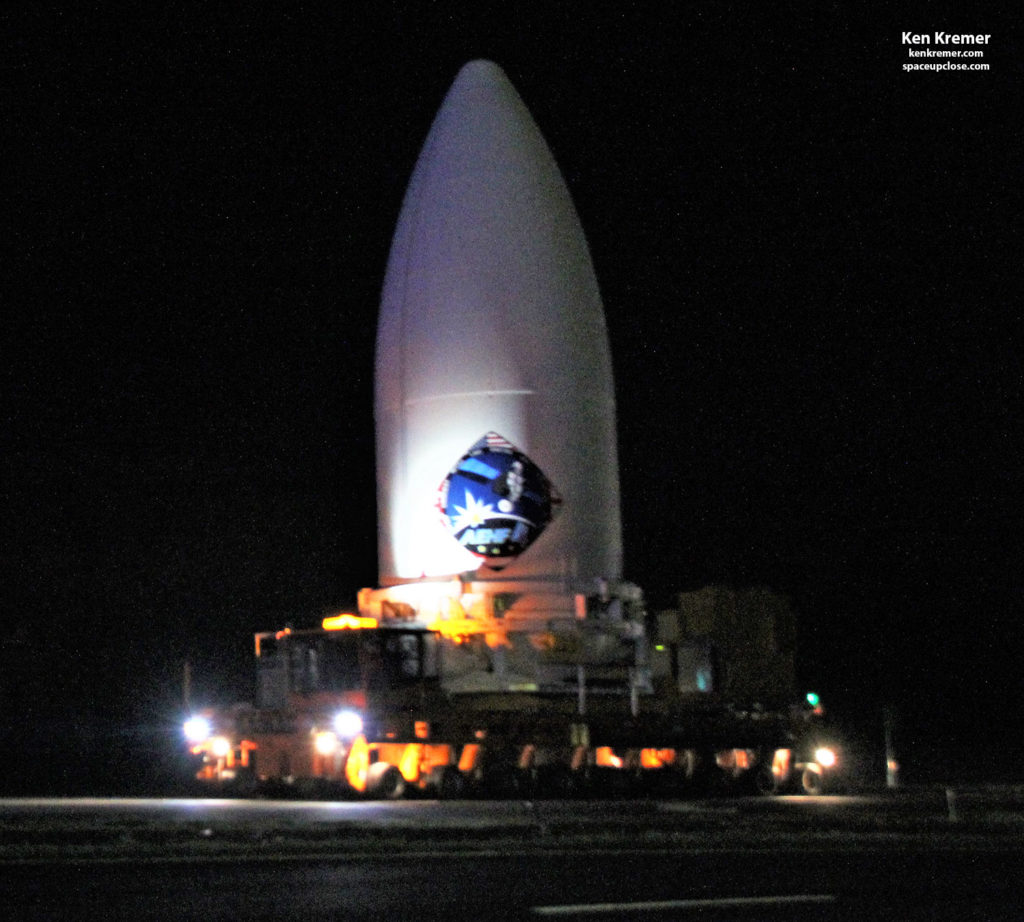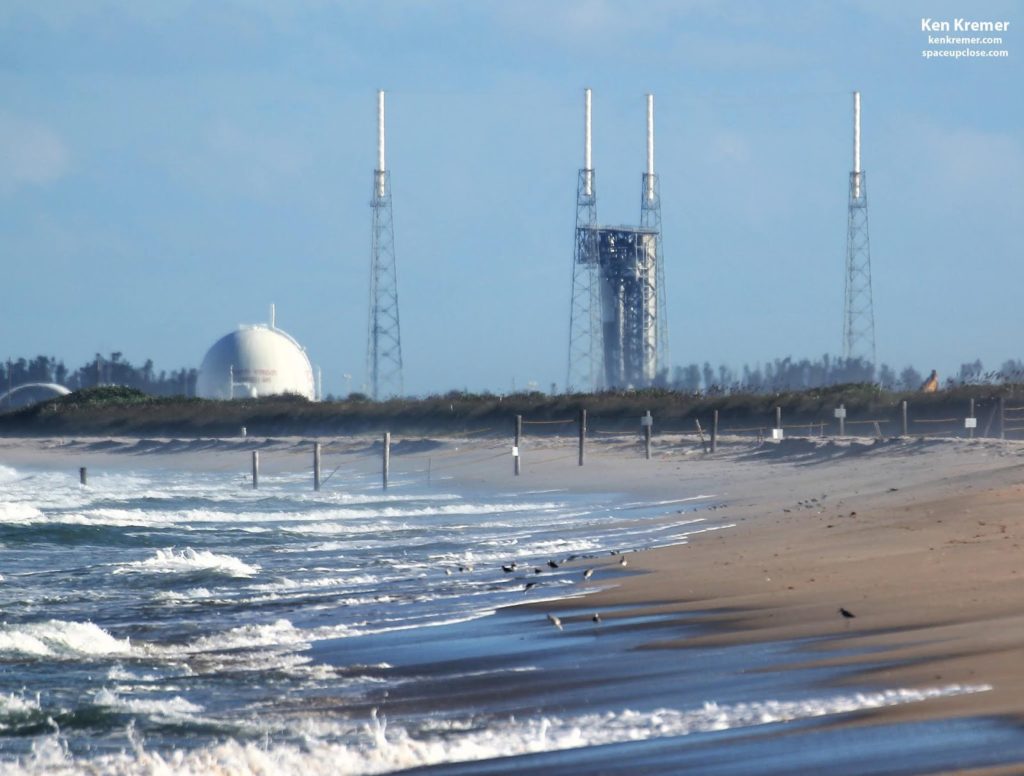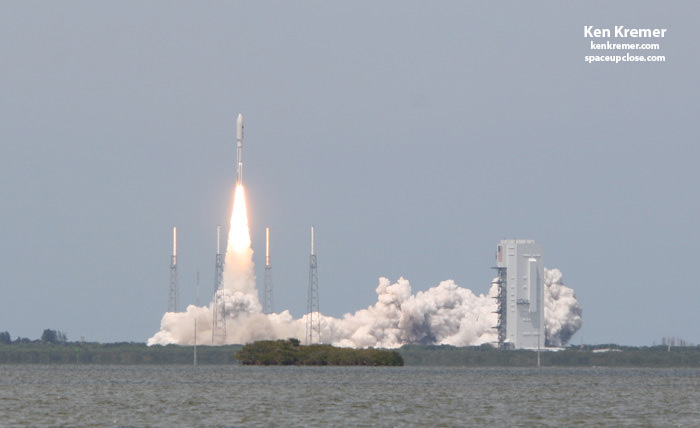— SpaceUpClose.com — 15 October 2018
TITUSVILLE, FL – A United Launch Alliance (ULA) Atlas V rocket
was moved to the launch pad this morning at Cape Canaveral setting up a just
past midnight launch of the AEHF-4 military communications satellite for the U.S. Air Force on Wednesday, October 17. And the weather prognosis is currently
very good!
The 197-foot-tall ULA Atlas V rocket journeyed 1,800 feet as
it was pushed by two trackmobiles from the Vertical Integration Facility (VIF) to
the Space Launch Complex 41 pad on the Florida Space Coast.
The move was completed by 11:10 a.m. EDT, Monday, Oct. 15, ULA reported.
ULA will use the most powerful variant of their workhorse Atlas
V rocket in the 551 configuration to launch the secure AEHF-4 milsatcom for Air
Force Space Command shortly after midnight on October 17 at 12:15 a.m. EDT (0415 GMT) from
Space Launch Complex-41 on Cape Canaveral Air Force Station, FL.
The 551 configuration includes a LOX & RP-1 kerosene-fueled
common core booster, a five-meter-diameter payload fairing built by RUAG
Space, five first stage strap-on solid rocket motors and a single engine LOX
& LH2 fueled Centaur upper stage.
Over the next few hours, ULA technicians work
included making “umbilical connections with launch pad systems, the
environmental control system feeding conditioned air to the rocket and payload
will be switched to facility supplies to allow the portable trailers used
during rollout to be unplugged and moved away, and the first stage will be
loaded with 25,000 gallons of RP-1 fuel, a highly refined kerosene.”
All systems are GO to start the countdown tomorrow,
Tuesday night for the USAF AEHF-4 – a
protected communications relay station in space for the U.S. military and
allies.
AEHF-4 is the fourth communications satellite in the Advanced
Extremely High Frequency (AEHF) series for U.S. Air Force Space Command.
AEHF-4 counts as the
newest and most advanced US Air Force jam-resistant protected military
communications satellite, and will play a vital role in U.S. national security.
satellite rolled out from a Titusville processing facility to its Cape
Canaveral launch pad in the dead of night Friday Oct. 5 for integration with
the mighty United Launch Alliance (ULA) Atlas V rocket that will propel it to
geostationary orbit (GEO) on October 17.
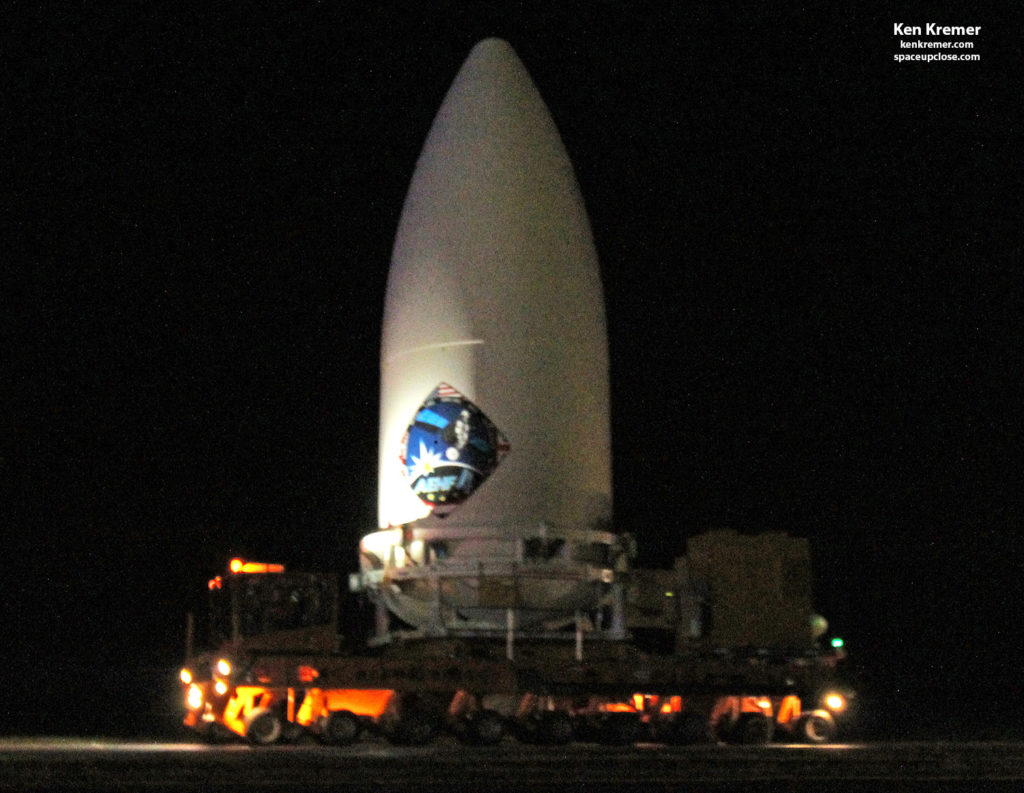 |
| Credit: Ken Kremer/kenkremer.com/spaceupclose.com |
Check out my eyewitness gallery of Space UpClose photos as I
observed the AEHF-4 convoy travel along public locations on Rt. 405 towards the
Cape – here and in our earlier story.
The launch countdown will begin Tuesday at
5:25 p.m. EDT (2125 GMT), according to ULA.
If all goes well liftoff happens nearly seven
hours later at 12:15 a.m. EDT (0415 GMT) on Wednesday.
The launch window extends for two hours until
2:25 a.m. EDT (0615 GMT).
ULA plans live countdown updates at their
countdown page starting on Tuesday at 5:15 p.m. EDT.
The live ULA webcast of the launch begins
Tuesday at 11:55 p.m. EDT and will be viewable on the ULA Home Page.
The weather forecast is currently quite good
with an 80 percent chance of acceptable conditions at launch time.
“On launch day and through the count, a front moves into the
southeast and slows, but high pressure remains centered over Central FL,” according
to the Air Force’s 45th Weather Squadron. “Isolated showers are possible
again with onshore winds from the SE near 10 kts. Thunderstorm chances remain
low over the Cape. For solar weather, there is a low threat of proton flux
exceeding constraints. The primary concern for launch is cumulus clouds with
onshore flow.
“AEHF provides survivable,
global, highly secure, protected, and jam-resistant communications for
high-priority military ground, sea, and air assets, between
U.S. national leadership [meaning the President] and deployed military forces, says USAF Space Command.
The AEHF constellation “provides 10
times the throughput and a substantial increase in coverage compared to the
1990s-era Milstar satellites” that it replaces and are currently in
orbit.
The satellite was built by
prime contractor Lockheed Martin at the satellite integration facility in
Sunnyvale, California, based on the A 2100 series communications satellite
spacecraft model and has a mass of some 6100 kg (13600 pounds).
“AEHF-4 delivery and launch
marks a significant milestone in fulfilling our communication commitment to the
highest priority Department of Defense ground, sea, and air missions.
It’s an important asset for the warfighter and will be employed for years to
come,” said Lt. Gen. John Thompson, Space and Missiles Systems Center
commander and Air Force program executive officer for space, in a statement.
This will be 131st mission for ULA since the
company was founded in 2006 and the 50th launch for the Air Force. It is the
79th for an Atlas V rocket and the 9th in the 551 configuration.
Watch for Ken’s
continuing onsite coverage of NASA, SpaceX, ULA, Boeing, Lockheed Martin,
Orbital ATK and more space and mission reports direct from the Kennedy Space
Center, Cape Canaveral Air Force Station, Florida and Wallops Flight Facility,
Virginia.
Stay tuned here for Ken’s continuing Earth and Planetary science
and human spaceflight news: www.kenkremer.com –www.spaceupclose.com –
twitter @ken_kremer – email: ken at kenkremer.com
scientist and journalist based in the KSC area.
………….
Ken’s photos are for sale and he is available for lectures and outreach events
Ken’s upcoming outreach events/photos for
sale:
Oct 16-17: Learn more about the Soyuz
abort and upcoming/recent ULA/USAF AEHF-4 milsatcom, NASA/ULA Parker
Solar Probe, SpaceX Merah Putih & Telstar 18 & 19 launches, SpaceX
Falcon 9/CRS-15 launch to ISS, Falcon Heavy, NASA TESS, GOES-S, NASA
missions, ULA Atlas & Delta launches, SpySats and more at Ken’s upcoming
outreach events at Kennedy Space Center Quality Inn, Titusville, FL, evenings.
Photos for sale
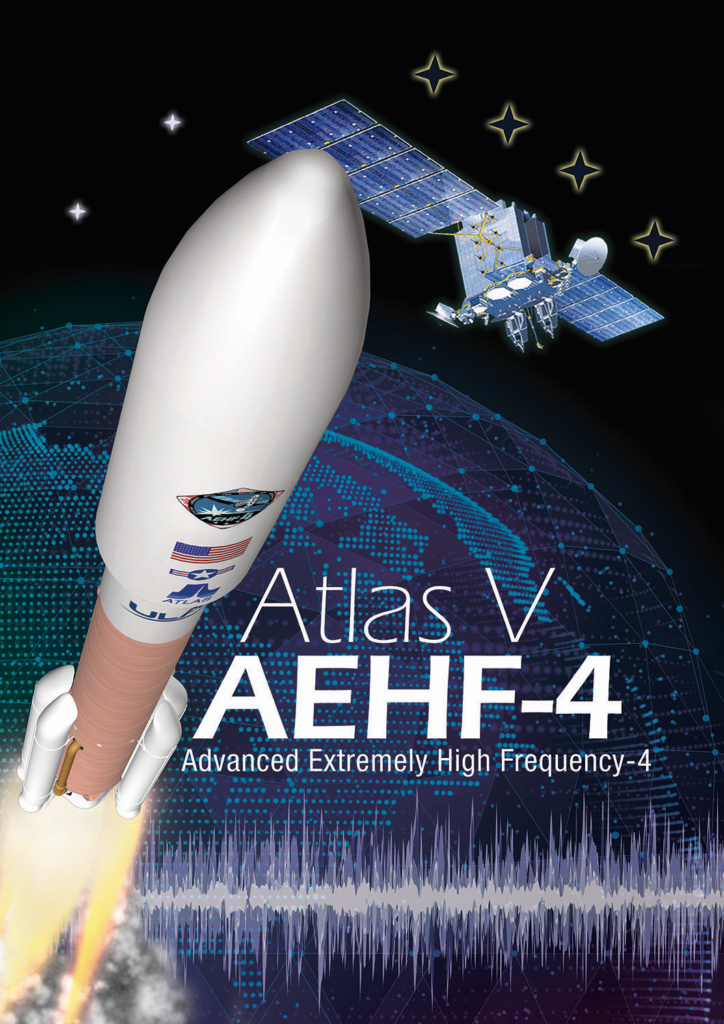 |
|
Advanced Extremely High Frequency-4 launch
poster on United Launch Alliance Atlas V rocket. Credit: United Launch Alliance |


